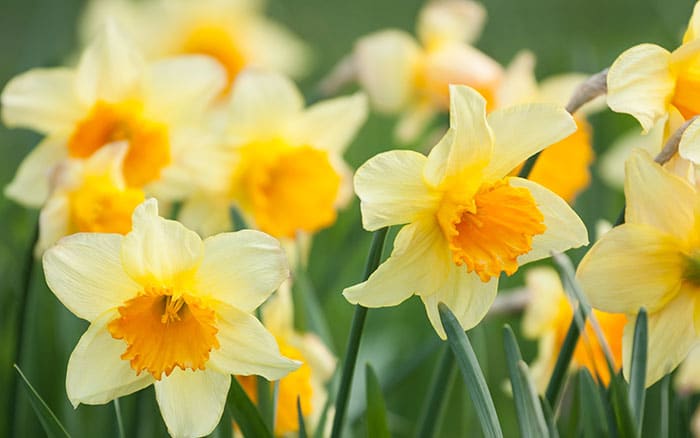Itchy eyes, a tickly nose, and constant sneezing. Hay fever’s back with a vengeance, and as many as 37% of people have developed symptoms for the first time in the last five years.
Hay fever’s not pleasant. Especially when all you want to do is sit in your garden, enjoying the sights, scents, and sun. That’s why I’ve made it my mission to help you pollen-proof your garden. From tactical plants to specific seating areas, take my advice to enjoy a sneeze-free summer.
Which plants are low in pollen?
Luckily, you have a rich choice of gorgeous low-to-no pollen plants. So, just because you suffer from hay fever, doesn’t mean you can’t have a beautiful garden.

Daffodils
Lots of us don’t realise that hay fever starts as early as March. This makes a great opportunity to grow bulb plants, like Daffodils. These are low pollen plants, so ideal for hay fever sufferers. With their bursts of gold and central orange trumpets, Daffodils are a firm and instantly recognisable favourite.
To enjoy Daffodils in March, plant them in early September, in fertile, well-drained conditions. They do best went planted at a depth of three times the height of the bulb.
Fun fact: Daffodils were originally brought to Britain by the Romans who believed the sap could heal wounds. In fact, Daffodil sap actually irritates the skin. So, definitely don’t try that at home!

Double-Flowered Hollyhocks
These easy-to-grow blooms are instantly recognisable for their glorious, towering stems and jewel-toned flowers. Plus, they’re also great for allergy sufferers, due to their low pollen count. Double-flowered Hollyhocks produce less pollen than single-flower Hollyhocks.
Producing masses of flowers in summer, these are best planted in spring or autumn, in fertile, well-drained soil. Just make sure they get full sun to get the tallest flower spikes!
Fun fact: Hollyhocks are the traditional flower used to celebrate 13th wedding anniversaries. There really is a flower for every occasion!

Snowdrops
These little bulbs are some of the first to flower in spring, but they certainly won’t be responsible for kick-starting your hay fever due to their low pollen levels. With small, dangling bell-shaped flowers of snow white, Snowdrops add a purity to your garden.
Plant these in generous drifts in late spring. They do well in most soil types but prefer shaded areas around deciduous trees and shrubs.
Fun fact: Contrary to popular belief, snowdrops are named after an earring style popular in the 15th, 16th, and 17th centuries, rather than literal drops of snow!
Where to put your seating area…
Of course, we all want to be able to sit in our gardens and relax when the sun’s out. But those refreshing gentle breezes can bring pollen with them. Causing those itchy eyes and runny noses to flare up. You can, however, create a wind trap in your garden to try and reduce the pollen’s impact.
Firstly, make note of the direction the wind tends to travel. Then, take a look at any pre-existing structures you have that might help block this. It could be walls, fencing, or low pollen shrubs or trees. Use this to place your furniture in the least windy spot.
If you don’t have any pre-existing structures, consider incorporating some low pollen shrubs, like Conifer. Some of the best choices include Cedars, Firs, and Junipers. Planted along garden boundaries, these can help to block out clouds of pollen and create privacy. Plus, they look great!
Consider also incorporating a trellis, complete with low pollen climbing plants. Star Jasmine and Ivy are great choices for creating those barriers, whilst also looking chic and allowing movement and light into your garden.

Ideally, if you suffer from allergies, it might be best to get some help cutting the lawn. But there are some things you can do to minimise the pollen’s impact.

Firstly, avoid raking. This stirs the settled pollen, sending it back into the air.
Where possible, use gloves to collect any unwanted matter on your lawn.
Make sure you dress to protect yourself, too. Long-sleeved clothing, masks, and goggles are a good idea. Just make sure you get changed as soon as you’re done mowing!
How can you help pollinators?
Of course, lower pollen gardens mean there’s less pollen for our beloved pollinators. It should be noted, however, that insect-pollinated plants tend to cause less hay fever than grass pollen and wind-pollinated plants.
And remember, low pollen doesn’t mean no pollen. So, if you can bare a sneeze from time to time, consider planting the likes of Hardy Geraniums, Begonias, and Viburnum. These are pollinator magnets, that won’t instantly get you tearing up!


Leave A Comment